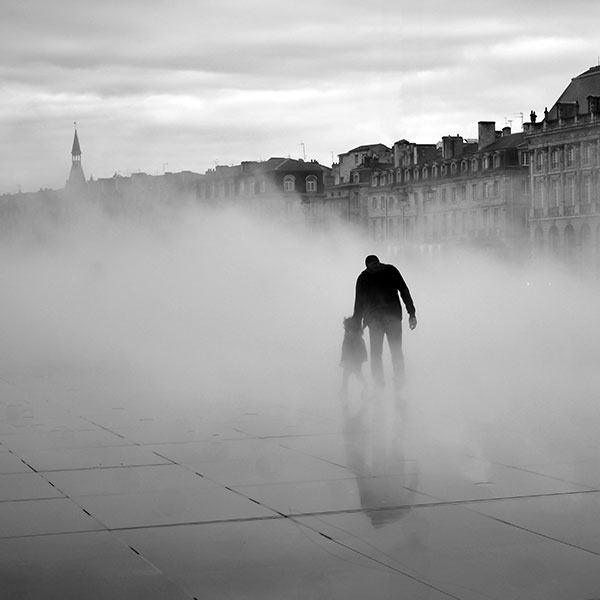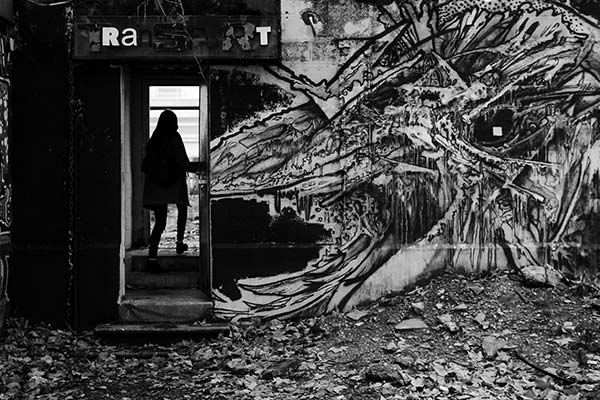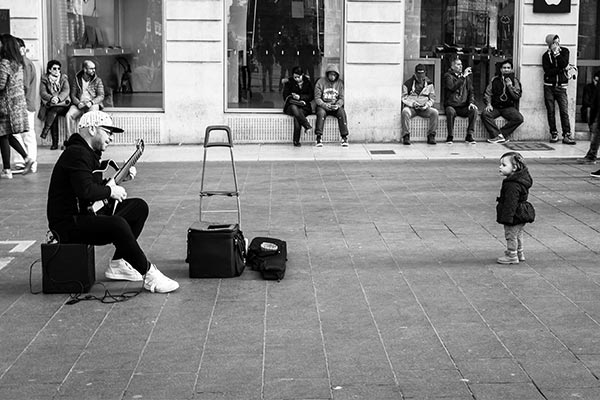Subtotal: $
Checkout-

Small Acts of Grace
-

In the Valley of Lemons
-

City of Clubs
-

Save Your Sympathy
-

From “In the Holy Nativity of Our Lord”
-

Digging Deeper: Issue 23
-

Beneath the Tree of Life
-

Sidewalk Ballet
-

The Eternal People
-

Robert Hayden’s “Those Winter Sundays”
-

The Pilgrim City
-

Not Just Personal
-

Editors’ Picks Issue 23
-

Madeleine Delbrêl
-

Covering the Cover: In Search of a City
-

Urban Series (Neighborhood)
-

In Search of a City
-

Readers Respond: Issue 23
-

Family and Friends: Issue 23
-

One Inch off the Ground
-

Re-Mapping Belfast
-

Serving Kings
-

Up Hill

The city stinks. This city, that city, every city everywhere: They reek of sour urine, old vomit, rotting food, the slow tidal surge of human excrement down in the sewers.
Want an image of the metropolis? A depiction of the thing in itself? Think of a night scene, like a cityscape in a photorealist painting, where a thin, scabrous rat scrabbles up from a storm drain to gnaw at a dead pigeon in the gutter. The abandoned warehouses, the smog-stained brick, make a dark canyon of the street, and trash skitters along the filthy sidewalk. High above, an illuminated billboard advertises diamonds, as worn by an elegant, near-orgasmic woman in a blue dress. Another brightly lit sign urges passersby – in a clumsy, overexcited red font – to call a shyster lawyer and sue someone. There’s even a picture of the lawyer on the sign. He wears a yellow tie and smirks.

Valentino Belloni, Father and Daughter
All photographs used by permission from Valentino Belloni
London, Los Angeles, Lahore: the place hardly matters. All urban spaces have that deep ineradicable stench of so many people so close together. They all decay. They foster the commerce of dishonesty. They breed disease. Peel back the centuries of cracked pavements. The subways, sewers, and rusted steam pipes. The stained soil crushed beneath the city’s unnatural weight. And even then we would not discover the enchanted whisper of beginning, the fresh green breast of a new world. Peel back the city to the time of its foundation. Peel back the corpses piled on corpses, the generations of violence. Peel it back to the bare ground of origin, and all we would find is the first grave of a founding murder. The city is built on death, all the way down. A city of bones.
There’s another city, too, of course. Or, at least, another way to see it: The city is the place of flowers, cut carnations and roses in buckets at the corner grocery. The city is the place of parks and tree-lined boulevards and flags waving over paved streets. The place of awnings and marble vestibules. The place of manners, for that matter: No civilization exists without the civitas. No urbanity without the urban. Nothing politic without the polis.
Want a counter image of a metropolitan world? Imagine, maybe, breakfasting on croissants and café au lait, “Early in the morning / Of a lovely summer day,” to quote the poet Robert Hillyer:
They were hosing the hot pavement
With a dash of flashing spray
And a smell of summer showers
When the dust is drenched away,
Under greenery like scenery,
Rue François Premier.
Or imagine being in a cityscape painting. Strolling, say, under an umbrella in Gustave Caillebotte’s Paris Street, Rainy Day. Or something in a softer focus, like Claude Monet’s Houses of Parliament, Sunset. For that matter, something harder edged, like Marc Chagall’s Paris through the Window.
The city is home to museums, symphonies, ballet, and opera – all the civilized arts that exist only thanks to public munificence. The virtue of generosity proves difficult for the rich: acts of charity are generous only when they come with sacrifice, and the truly wealthy sacrifice little even when they give much. But Aristotle gives us another name for the good act of making grand gifts. He calls it the virtue of munificence: donations to public life so large that only the wealthy can undertake them. And the city is the place where munificence can flower.
The great cities are neither vile stinkpots nor enchanted gardens.
The place of bustle and beauty. The location of charity and civilization. A land of fountains. The home for vast swaths of the laughter and joy of human interaction. The city is the woman leaning against the man on the park bench on a summer’s weekend morning. The city is the Salvation Army Santa who rings his bell and laughs as the Christmas snow flitters down. The city is the people streaming by who smile and push a dollar bill into his red kettle. The city is the schoolgirl in the navy-blue tam who ducks behind a tree to hide from her dog, then relents and darts out to scoop the anxious dachshund up into a hug. A city of small graces.
Of course, no one has ever truly lived in either of these, the City of Bones or the City of Graces. We experience only some strange amalgam of them both: corruption and decency, malice and benevolence, side by side. The great cities are neither vile stinkpots nor enchanted gardens. Not completely. They are only beautiful failures and corrupt successes.
Even the city besieged by warfare has its redeeming virtues. Even the most glittering utopia has its hidden sins.
Wicked Sodom and Gomorrah seem to manifest the deep truth about cities – until, suddenly, they don’t.
Where does the city come from? Economics is often invoked to explain the birth of cities in ancient times, and fair enough: the city has proved to be the greatest economic engine the world has ever known. But when human beings first gave up nomadic life, it was not because they understood the financial advantages of collected reservoirs of capital and the monetary effects of the division of labor. Even the word economics shows its late origin: Derived from oikonomia, the ancient Greek word for managing a household, economics became a term for the king’s budget, the management of the royal household, and thereby grew in late medieval times to mean the financial management of the nation.
In The Ancient City (1864), the historian Fustel de Coulanges makes the case that the birth of the city is literally from the grave. Coulanges argues that nomadic peoples tended to bury their dead in particular spots. And that gradually led to temples near the tombs, then marketplaces near the temples, then houses near the marketplaces.
Then of course there is political theory, civilization as refuge from Thomas Hobbes’s nasty, brutish state of nature. In anthropology, René Girard points out that mythology almost always places death at the birth of civilization. Perhaps the city was born from fear about our own deaths. Or perhaps the city was born from grief at the death of others. Either way, the city begins with death.
In the Bible, the first city is founded by Cain, the first murderer. From there on, Scripture radiates a steady mistrust of cities – a constant sense that cities are defined by the temptations they offer, the occasions they provide for sin. Prophets come from the desert and the pastures; corruption comes from the city. Even in the Holy Land, the Ark of the Covenant rests in the country camp of Shiloh, rather than in the conquered cities. Wicked Sodom and Gomorrah seem to manifest the deep truth about cities – until, suddenly, they don’t. The Psalms, and then the prophets after David, offer a different vision of the city. Its name is Jerusalem.
This is how Saint Augustine reads civic history in The City of God. “Cain (signifying ‘possession’), the founder of the earthly city, and his son Enoch (meaning ‘dedication’), in whose name it was founded, indicate that this city is earthly both in its beginning and in its end – a city in which nothing more is hoped for than can be seen in this world.” Augustine points out how Genesis specifies the professions of the line of Cain: six generations on, there is Jabal, “the father of such as dwell in tents, and of such as have cattle”; Jubal, “the father of all such as handle the harp and organ”; Tubal-Cain, “an instructor of every artificer in brass and iron”; and Naamah, whose name means beauty or pleasure.
These brothers are described as founding the skills necessary for city life, and their sister helps establish the temptations of the city – including (according to rabbinical interpretations) her beautiful songs for worshiping idols. What follows is the brief poem, the “Song of the Sword,” that their father, Lamech, sings:
Hear my voice; ye wives of Lamech,
hearken unto my speech:
for I have slain a man to my wounding,
and a young man to my hurt.
If Cain shall be avenged sevenfold,
truly Lamech seventy and sevenfold.
(Gen. 4:23–24)
The origin in violence was signaled when Cain established the first city, and the continuing violence was declared in Lamech’s “Song of the Sword.” The City of Bones is built on murder, all the way down.
But then David brings the Ark into Jerusalem, and the Bible begins to tell a counter story. Before David, the Bible contrasted the sinful violence of the city with the peace of Eden, the idyllic world of innocence in the garden. After David, the Bible tends to contrast the violence and corruption of the actual city – such as Babylon and Nineveh – with the peace of the ideal city.

Valentino Belloni, Crunched
Isaiah famously promises that when God judges among the nations, the people of earth “shall beat their swords into plowshares, and their spears into pruning hooks: nation shall not lift up sword against nation, neither shall they learn war anymore” (Isa. 2:2–4). But that prophecy comes immediately after the assurance that “out of Zion shall go forth the law, and the word of the Lord from Jerusalem” – a peace that can derive only from a holy city, not a city of death. And even then, it is only promised “in the last days” – an apocalyptic ideal of the city, not its reality even in the actual present city of Jerusalem.
Augustine argues that this is a vision of the City of God, which stands over against the City of Man. We must live in one city: the polis, with its civic structures struggling to constrain the constant threat of escalating violence. But we are called to the other city: the idea of the New Jerusalem, which develops from the prophesies of Ezekiel through the Book of Revelation.
The Bible begins with a garden and ends with a city, as Jacques Ellul and others after him have noted. In The Meaning of the City (1951), Ellul argues that God’s plan develops through sacred history along this trajectory. Ellul himself was suspicious of actual cities, seeing urban life as a constraint on human freedom and autonomy. But he recognizes the apocalyptic picture of Revelation as an important departure from other ancient religions: the Bible does not promise a return to idyllic beginnings. In place of the first innocence of the Garden of Eden, we have the second innocence of the New Jerusalem, where “there shall be no more curse” (Rev. 22:3–4). This “great city, the holy Jerusalem, descending out of heaven from God” promises an end to the emotions of death – both anxiety at our own deaths and grief at the deaths of others: “And God shall wipe away all tears from their eyes; and there shall be no more death, neither sorrow, nor crying, neither shall there be any more pain: for the former things are passed away” (Rev. 21:4–18).
How to understand human cities against this prophetic ideal?
Oh, we’ve pictured the city righteously destroyed, like Sodom and Gomorrah. Nathanael West’s 1939 novel about hateful Los Angeles, The Day of the Locust, ends with a picture of the city burning: the dry Santa Ana winds pulling out all the moisture from the wooden bungalows till they are nothing but kindling for the great cleansing fire. We’ve even pictured the city as deserving a destruction that never quite comes, as though God had abandoned even his wrath against us. The billboard, advertising an optometrist, that looms above the valley of ashes in The Great Gatsby, for example: “Above the grey land and the spasms of bleak dust which drift endlessly over it, you perceive, after a moment, the eyes of Doctor T. J. Eckleburg.”
But in the vision of a city not founded on murder, we may spy a path to redemption for the actual cities in which we dwell. It is precisely our call to the not-yet-come City of God that allows us to work for the bettering of the City of Man. William Blake, taking in the “dark Satanic Mills” of industrial England, imagines the apocalypse restoring nature and holiness to the troubled earth, and commits himself: “I will not cease from Mental Fight, / Nor shall my sword sleep in my hand: / Till we have built Jerusalem, / In England’s green & pleasant Land.”

Valentino Belloni, Private Concert
Yet even the desire to perfect the earthly city can result in a reenacting of the sin of Cain. An extreme example is the Taiping Rebellion – the bloodiest human conflict outside the world wars – which captured Nanking in 1853, and renamed it “New Jerusalem.”
In New York, the herds of yellow taxis stampede down Fifth Avenue to Washington Square, on through the switchback ravines of Greenwich Village, and on to the canyons of Wall Street. Across the ocean, similar herds stream through London. Krakow may be all the way around the world from Salvador da Bahia, but in both the Polish royal town and the Brazilian colonial city, you can walk among the old high Catholic buildings – proving that all we need to have block after block of surviving Baroque architecture is a city that was wealthy at the right moment and too poor in later centuries to tear it down and build something new. Even with all their differences, cities mirror other cities’ traits and features.
Ankara, Brasília, Versailles, and Las Vegas, for example. Each as different as can be, but they share something strange: a disquieting uniformity in the eras of their architecture, the result of being built all at once. Rome, Ezra Pound once complained, is the only city run like a museum. But every Mediterranean city sometimes feels that way. Every city on a coast, Albert Camus once pointed out, turns either its back or its face to the sea. Charleston and Miami are American cities with their bright faces to the water. Tacoma and New York are cities that have turned inward, pushing their dark warehouses near the ocean.
Yet even the desire to perfect the earthly city can result in a reenacting of the sin of Cain.
I remember sitting once, late at night, in a diner in South San Francisco, reading Ron Hansen’s 1996 novel, Atticus. The fog pulsed by the windows in waves. The airplanes at the nearby airport roared every few moments. The coffee was the old American standard of percolator-burned pale brown swill. And the novel – ah, yes, the novel. In his Prodigal Son–framed tale of a modern rancher and his missing son, Hansen built an elaborate symbol from a sundog, that odd atmospheric phenomenon in which a small second sun seems to float around 22 degrees off to the left or right of the actual sun. In Atticus, the sundog seemed to symbolize the relation of fathers and sons, and the strangeness of the physical world, and maybe even the Eucharist.
Could there be a rich symbol like that for the city?
Down in its inward essence, the city is vile. Up at its true ideal, the city is noble. We’ve only experienced the mixed middle thing: a little bit cursed, a little bit blessed. An occasion of sin and an opportunity for charity. A stain of ugliness and a flash of beauty.
A human thing, in other words – laden with the guilt of Cain, but straining toward the New Jerusalem.
Already a subscriber? Sign in
Try 3 months of unlimited access. Start your FREE TRIAL today. Cancel anytime.


































Bob Taylor
Such excellent writing! But in a fallen world, let's not even come close to forgetting, the most appalling acts of violence can occur in the most beautiful, arboreal settings, and the most staggering acts of Christlike sacrifice can happen in the most hellish urbanscapes.